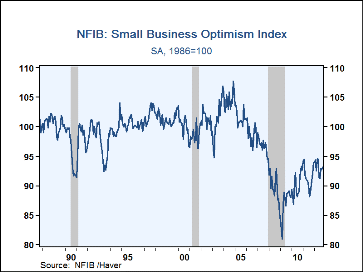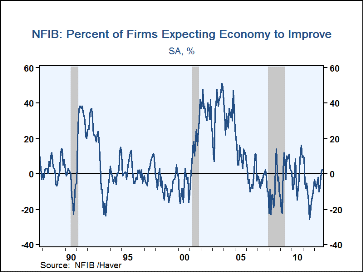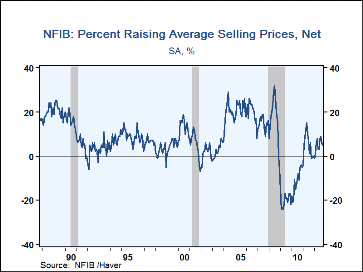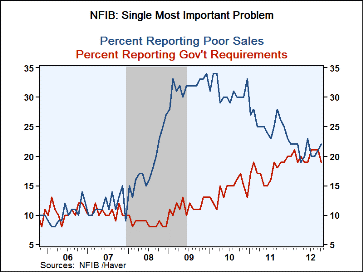 Global| Nov 13 2012
Global| Nov 13 2012U.S. Small Business Optimism Improves M/M, But Worries Persist
by:Tom Moeller
|in:Economy in Brief
Summary
The National Federation of Independent Business indicated that its October Index of Small Business Optimism improved to 93.1 from 92.9 in September. While the figure was well above the recession low, it remained depressed versus past [...]
The National Federation of Independent Business indicated that its October Index of Small Business Optimism improved to 93.1 from 92.9 in September. While the figure was well above the recession low, it remained depressed versus past economic expansions. A stable 2% of firms expected the economy to improve but that compared to 20%+ at this stage of past economic recoveries. The same can be observed by the 3% which expected higher real sales in six months. The percent of firms with one or more job openings slipped m/m to a relatively low 16%. A modest 4% percent of firms planed to increase employment and a relatively low 22% planned on increasing capital expenditures.
The percentage of firms reporting that credit was harder to get fell to 7%, down sharply from the early-2009 high of 16%. The 9% of firms planning to raise worker compensation was up from the recession low of 0%. The percentage of firms lifting prices slipped to 5% while the 16% who were planning to raise prices was up from none at the recession low.
The most important problems faced by small business were poor sales (22%), taxes (20%), government requirements (19%), insurance cost & availability (8%), competition from large businesses (7%), inflation (6%), quality of labor (5%), cost of labor (3%) and financial & interest rates (3%).
Roughly 24 million small businesses exist in the U.S. and they create 80% of all new jobs. The typical NFIB member employs 10 people and reports gross sales of about $500,000 a year. The NFIB figures can be found in Haver's SURVEYS database.
| National Federation of Independent Business | Oct | Sep | Aug | Oct'11 | 2011 | 2010 | 2009 |
|---|---|---|---|---|---|---|---|
| Small Business Optimism Index (SA,1986=100) | 93.1 | 92.8 | 92.9 | 90.2 | 91.4 | 89.9 | 86.7 |
| Firms Expecting Higher Real Sales In Six Months (Net %) | 3 | 1 | 1 | -4 | 3 | 1 | -11 |
| Firms Expecting Economy To Improve (Net %) | 2 | 2 | -2 | -16 | -9 | -1 | -0 |
| Firms With One or More Job Openings (Net %) | 16 | 17 | 18 | 14 | 14 | 10 | 9 |
| Firms With Few or No Qualified Applicant For Job Openings (Net %) | 38 | 41 | 37 | 31 | 32 | 27 | -- |
| Firms Reporting That Credit Was Harder To Get (Net %) | 7 | 6 | 7 | 11 | 10 | 13 | 14 |
| Firms Raising Avg. Selling Prices (Net %) | 5 | 6 | 9 | -1 | 5 | -12 | -20 |
Tom Moeller
AuthorMore in Author Profile »Prior to joining Haver Analytics in 2000, Mr. Moeller worked as the Economist at Chancellor Capital Management from 1985 to 1999. There, he developed comprehensive economic forecasts and interpreted economic data for equity and fixed income portfolio managers. Also at Chancellor, Mr. Moeller worked as an equity analyst and was responsible for researching and rating companies in the economically sensitive automobile and housing industries for investment in Chancellor’s equity portfolio. Prior to joining Chancellor, Mr. Moeller was an Economist at Citibank from 1979 to 1984. He also analyzed pricing behavior in the metals industry for the Council on Wage and Price Stability in Washington, D.C. In 1999, Mr. Moeller received the award for most accurate forecast from the Forecasters' Club of New York. From 1990 to 1992 he was President of the New York Association for Business Economists. Mr. Moeller earned an M.B.A. in Finance from Fordham University, where he graduated in 1987. He holds a Bachelor of Arts in Economics from George Washington University.










